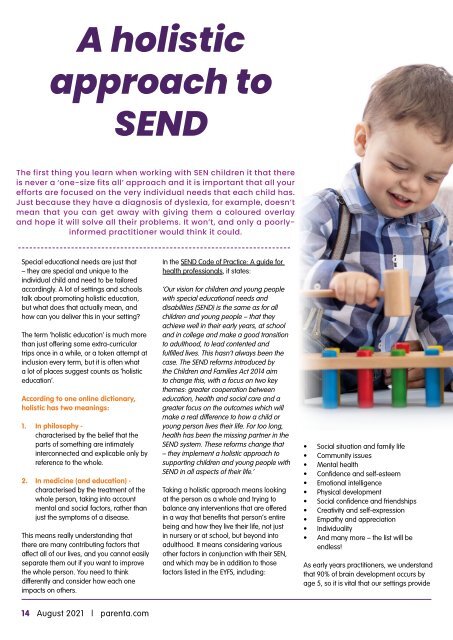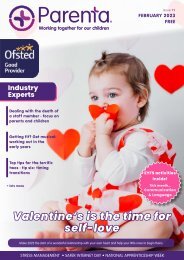August 2021 Parenta magazine
- No tags were found...
You also want an ePaper? Increase the reach of your titles
YUMPU automatically turns print PDFs into web optimized ePapers that Google loves.
Consider:<br />
A holistic<br />
approach to<br />
• Are there ways to combine<br />
interventions to get the best outcome?<br />
• Are you considering health issues?<br />
• Are you considering social issues?<br />
• How will your work impact on other<br />
areas of the child’s life?<br />
• Can you involve others to help?<br />
SEND<br />
Partnering with others<br />
The first thing you learn when working with SEN children it that there<br />
is never a ‘one-size fits all’ approach and it is important that all your<br />
efforts are focused on the very individual needs that each child has.<br />
Just because they have a diagnosis of dyslexia, for example, doesn’t<br />
mean that you can get away with giving them a coloured overlay<br />
and hope it will solve all their problems. It won’t, and only a poorlyinformed<br />
practitioner would think it could.<br />
Special educational needs are just that<br />
– they are special and unique to the<br />
individual child and need to be tailored<br />
accordingly. A lot of settings and schools<br />
talk about promoting holistic education,<br />
but what does that actually mean, and<br />
how can you deliver this in your setting?<br />
The term ‘holistic education’ is much more<br />
than just offering some extra-curricular<br />
trips once in a while, or a token attempt at<br />
inclusion every term, but it is often what<br />
a lot of places suggest counts as ‘holistic<br />
education’.<br />
According to one online dictionary,<br />
holistic has two meanings:<br />
1. In philosophy -<br />
characterised by the belief that the<br />
parts of something are intimately<br />
interconnected and explicable only by<br />
reference to the whole.<br />
2. In medicine (and education) -<br />
characterised by the treatment of the<br />
whole person, taking into account<br />
mental and social factors, rather than<br />
just the symptoms of a disease.<br />
This means really understanding that<br />
there are many contributing factors that<br />
affect all of our lives, and you cannot easily<br />
separate them out if you want to improve<br />
the whole person. You need to think<br />
differently and consider how each one<br />
impacts on others.<br />
In the SEND Code of Practice: A guide for<br />
health professionals, it states:<br />
‘Our vision for children and young people<br />
with special educational needs and<br />
disabilities (SEND) is the same as for all<br />
children and young people – that they<br />
achieve well in their early years, at school<br />
and in college and make a good transition<br />
to adulthood, to lead contented and<br />
fulfilled lives. This hasn’t always been the<br />
case. The SEND reforms introduced by<br />
the Children and Families Act 2014 aim<br />
to change this, with a focus on two key<br />
themes: greater cooperation between<br />
education, health and social care and a<br />
greater focus on the outcomes which will<br />
make a real difference to how a child or<br />
young person lives their life. For too long,<br />
health has been the missing partner in the<br />
SEND system. These reforms change that<br />
– they implement a holistic approach to<br />
supporting children and young people with<br />
SEND in all aspects of their life.’<br />
Taking a holistic approach means looking<br />
at the person as a whole and trying to<br />
balance any interventions that are offered<br />
in a way that benefits that person’s entire<br />
being and how they live their life, not just<br />
in nursery or at school, but beyond into<br />
adulthood. It means considering various<br />
other factors in conjunction with their SEN,<br />
and which may be in addition to those<br />
factors listed in the EYFS, including:<br />
• Social situation and family life<br />
• Community issues<br />
• Mental health<br />
• Confidence and self-esteem<br />
• Emotional intelligence<br />
• Physical development<br />
• Social confidence and friendships<br />
• Creativity and self-expression<br />
• Empathy and appreciation<br />
• Individuality<br />
• And many more – the list will be<br />
endless!<br />
As early years practitioners, we understand<br />
that 90% of brain development occurs by<br />
age 5, so it is vital that our settings provide<br />
experiences that support the whole child,<br />
including the above bullet points, and it is<br />
why we should provide multiple areas of<br />
stimulation through enriched and diverse<br />
environments, but understand how each<br />
affects the other.<br />
In many educational settings, children<br />
with special needs are often taken out of<br />
subjects they do well at (such as Art or<br />
Drama), in favour of studying Maths or<br />
English, but this can impact negatively on<br />
their self-esteem when they feel they are<br />
missing a subject that supports them in<br />
other ways. This is just an example, but it<br />
raises questions about whether the child’s<br />
preferences could be taken into account<br />
in a more holistic approach, that doesn’t<br />
impact negatively on their mental health to<br />
serve an academic outcome. In early years,<br />
we may fall into the trap of focusing on one<br />
small thing at the expense of a larger other.<br />
Many children with special needs also<br />
have more than one learning difficulty -<br />
people with autism can also have sensory<br />
issues, and people with dyslexia may have<br />
dyspraxia. The challenge here is to try to<br />
try to meet all of the needs in the best way<br />
possible. This is where good planning and<br />
communication are vital.<br />
To provide a holistic approach to SEND, it<br />
is vital you form partnerships with other<br />
people and agencies. When information is<br />
shared appropriately, instead of having just<br />
one piece of the jigsaw, everyone will begin<br />
to see the whole picture.<br />
Parents are obviously the first port of call<br />
and will have insights that you do not, and<br />
vice versa, so setting up regular sessions to<br />
talk to the parents will help you understand<br />
what their child needs; you can also tell<br />
parents what is working well in the setting,<br />
so they can continue the practice at home.<br />
Remember too that many parents of<br />
special needs children are under enormous<br />
stress themselves, which can impact their<br />
own mental health and wellbeing, and<br />
subsequently, that of the child. Offering<br />
help and support to parents via advice/<br />
support groups, meetings or just passing<br />
on relevant information that could be useful<br />
to them, will have an impact.<br />
You should also develop partnerships with<br />
health and social care services, and they<br />
should be contacting you for updates,<br />
reviews and progress reports. By working<br />
together, plans such as EHCPs can be<br />
drawn up effectively to really support the<br />
whole child, but ensure they are regularly<br />
reviewed and amended to grow with the<br />
child.<br />
Supporting your SENCo<br />
Your SENCo will have ultimate responsibility<br />
for the outcomes and provision for<br />
children with special needs, but could<br />
you support them better by training your<br />
staff or increasing cooperation between<br />
colleagues? There are many CPD courses<br />
which raise awareness of SEND issues and<br />
there is no substitute for regular meetings<br />
with colleagues to check on a child’s<br />
progress across the board to consider<br />
holistic issues.<br />
14 <strong>August</strong> <strong>2021</strong> | parenta.com<br />
parenta.com | <strong>August</strong> <strong>2021</strong> 15

















